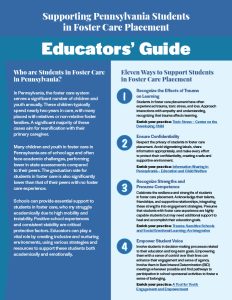Who are Students in Foster Care in Pennsylvania?
In Pennsylvania, the foster care system serves a significant number of children and youth annually. These children typically spend nearly two years in care, with many placed with relatives or non-relative foster families. A significant majority of these cases aim for reunification with their primary caregiver.
Many children and youth in foster care in Pennsylvania are of school age and often face academic challenges, performing lower in state assessments compared to their peers. The graduation rate for students in foster care is also significantly lower than that of their peers with no foster care experience.
Schools can provide essential support to students in foster care, who my struggle academically due to high mobility and instability. Positive school experiences and consistent stability are critical protective factors. Educators can play a vital role by creating inclusive and nurturing environments, using various strategies and resources to support these students both academically and emotionally.
Eleven Ways to Support Students in Foster Care Placement

Recognize the Effects of Trauma on Learning
Students in foster care placement have often experienced trauma, toxic stress, and loss. Approach interactions with empathy and understanding, recognizing that trauma affects learning.
Enrich your practice: Toxic Stress – Center on the Developing Child

Ensure Confidentiality
Respect the privacy of students in foster care placement. Avoid stigmatizing labels, share information appropriately, and make every effort to protect their confidentiality, creating a safe and supportive environment.
Enrich your practice: Information Sharing in Pennsylvania – Education and Child Welfare

Recognize Strengths and Presume Competence
Celebrate the resilience and strengths of students in foster care placement. Acknowledge their talents, friendships, and supportive relationships, integrating these strengths into engagement strategies. Presume that students with foster care experience are highly capable students but may need additional support to heal and accomplish their education goals.
Enrich your practice: Trauma-Sensitive Schools and Social Emotional Learning: An Integration

Empower Student Voice
Involve students in decision-making processes related to their education and long-term goals. Empowering them with a sense of control over their lives can enhance their engagement and sense of agency. Involve them in Best Interest Determination (BID) meetings whenever possible and find pathways to participation in school-sponsored activities to foster a sense of belonging.
Enrich your practice: A Tool for Youth Engagement and Empowerment

Support During Transitions through Collaboration
Students in foster care placement may experience frequent transitions, which sometimes necessitate a school move. Offer continuity and stability by ensuring smooth school moves via expedited records transfers and collaboration with other school departments. This may include student services, enrollment and registration, student assistance programs (SAP), and Child Accounting.
Enrich your practice: Foster Care Student School Stability Tool and Pennsylvania Statewide Foster Care Education Directories

Establish Students in the School Community
When welcoming a new student who has enrolled due to a foster care placement, ensure they feel welcomed, equipped, and prepared to attend their new school. Take steps to integrate the student and their foster family or kin into the school. Give the student a tour, ask about their interests, introduce them to teachers and student groups, and begin planning their class schedule. Create opportunities for them to exercise their agency. Connect with families to welcome them to the school and describe the educational resources available to their child in foster care placement.
Enrich your practice: Guide for Schools: Meeting the Needs of Students in Foster Care

Address Educational Gaps and Accelerate Learning
Many students in foster care placement enter with educational gaps due to absenteeism, changes in schools, and other factors. Provide targeted support to help bridge these gaps and ensure academic success. Seek and request academic records and assess all credits, partial credits, and prior work completed. Be flexible when assessing prior work and provide necessary accommodations to support their academic progress.
Enrich your practice: Foster Care for Children: Information for Educators

Assess the Application of Act 1 of 2022
Students in foster care placement who have experienced “education instability” — meaning one or more school changes in school entity enrollment during a single school year — are eligible for assistance under Pennsylvania law. Act 1 provides students with a Point of Contact, equal access, fees elimination, graduation progress assessment, and considers alternative pathways to graduation.
Enrich your practice: Act 1 of 2022 – Assisting Students Experiencing Education Instability

Connect Students to Resources
Students with foster care experience may be eligible for resources including transition to adulthood programs, post-secondary tuition support, and extended health care coverage. Identify and connect these resources to students to help them achieve their academic and career goals and connect with child welfare agencies to discuss their participation.
Enrich your practice: Know Your Rights Guide

Understand Legal Education Protections and Guidance
Familiarize yourself and ensure compliance with federal legislation and state school codes supporting and affecting students in foster care placement. Protections include school stability and policies regarding school enrollment and attendance.
Enrich your practice: Laws and Guidance

Collaborate with Child Welfare Agencies
Establish partnerships with child welfare professionals to coordinate support for students in foster care placement. Collaborate on Best Interest Determinations (BID), school placements, and transportation arrangements to ensure the student’s well-being and educational success. Plan to connect with your child welfare agency contacts at a minimum of the beginning and end of the school year to review students in foster care placement enrolled in your school and update records if placement changes have occurred.
Enrich your practice: Education Liaison Directory and What is Child Welfare? A Guide for Educators

